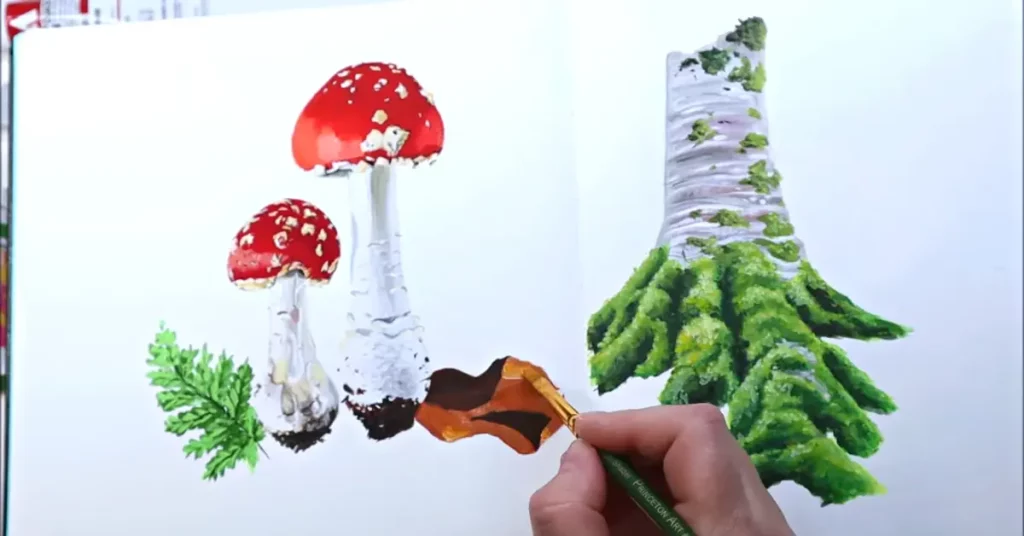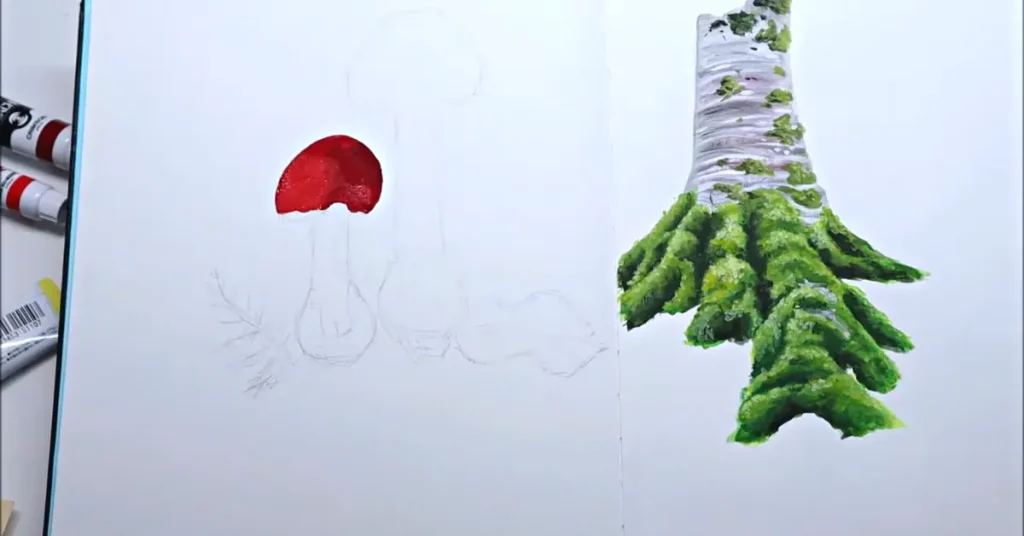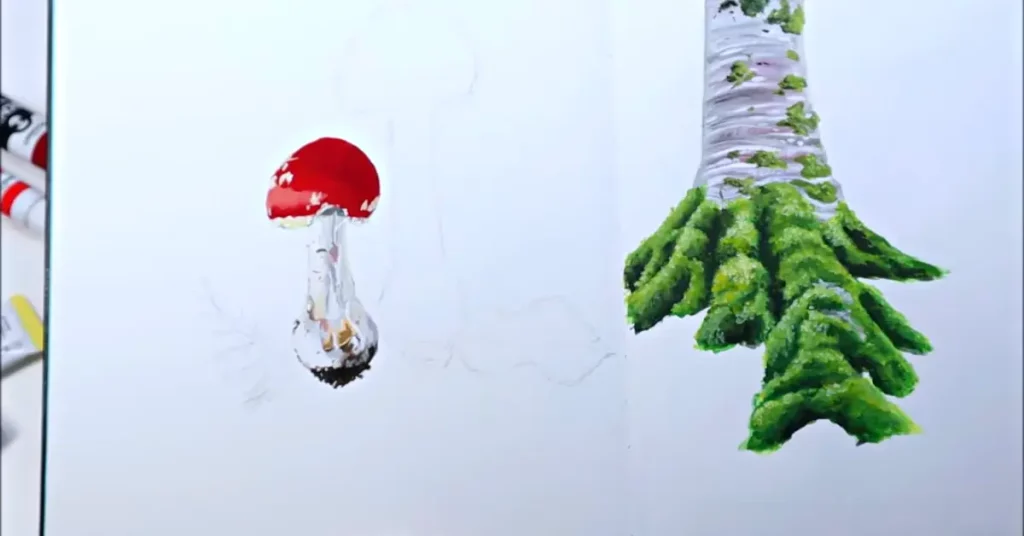Doing a pencil drawing before starting an acrylic painting can help you understand how the final painting will be. But will acrylic paint cover the Pencil on canvas? So that you can bring essential changes before starting acrylic painting and get a successful final piece.
Yes, acrylic paint will cover Pencil on canvas. It is a strong and durable paint that can easily obscure the marks made by Pencil. It will give you a smooth, uniform surface.

In this guide, we will discuss the reasons for using pencil on canvas, the properties of acrylic paints, and special tips before start painting acrylic.
What are the Reasons for using Pencil on canvas?
There are several logics that an artist can use Pencil on canvas before painting.
Sketching:
Pencil sketching allows the painter to erase and redraw a design to create a successful painting with a smoother finish.

Adding texture:
You can use Pencil to add texture to a painting by layering lines or shading differently.
Under drawing:
Some artists use Pencil as an underdrawing for acrylic painting out the basic composition and values before adding layers of paint.
Drawing details:
A pencil is an excellent tool for adding fine details to a painting to create precise lines and add subtle nuances to work.
Experimenting:
A pencil is also a good medium for experimentation because it can be easily erased or covered up.
What are acrylic paint and its properties?
Acrylic paint is made of acrylic polymer emulsion pigment that can dry fast. It is water-soluble when wet. Acrylic can resist water when it is dried. They are also very versatile and easy to use with water and various techniques.
One of the key properties of acrylic paint is its fast-drying nature. This makes it an ideal choice for artists who need to work quickly and those who need more time or space to wait for oil paints to dry. Acrylic paints are also non-toxic and easy to clean up.
Another property of acrylic paint is its ability to be thinned with water. It makes it easy to adjust the consistency. Besides, it achieved varieties effects, from thin, transparent washes to thick and opaque layers.
Covering Pencil with acrylic paint

You can use acrylic paint to cover Pencils on canvas in several ways. Here are a few options you could try:
Gesso primer:
Gesso is a type of primer specifically designed for use on canvas. It is made from a mixture of paint, chalk, and pigment. Note that it provides a smooth, white surface for you to paint.
Multiple layers of paint:
Another option is to cover the pencil marks by applying multiple layers of acrylic paint. You can either use a single color of paint or layer different colors to create a more complex effect.
Acrylic mediums:
You can also use acrylic mediums to cover pencil marks on the canvas. One option is to use an acrylic glaze, a transparent layer of paint, to create a translucent effect.
Tips and tricks for successfully covering Pencil with acrylic paint

- Start by lightly sanding the surface of the Pencil drawing to rough it up slightly.
- Use a light touch when applying the paint because it can cause the pencil lines to smudge.
- Allow each layer of paint to dry completely before adding the next.
- If you want to create a smooth, even finish so you can lightly sand the surface again after the final coat of paint has dried.
- You can also use a workable fixative on the Pencil drawing before painting to avoid smudging the pencil lines. Also, use the best pencil to sketch on canvas before acrylic painting. It will help hold the pencil lines in place and make it easier to paint over them.
- If the paint is not covering the pencil lines well, try using thicker paint. Just allow each layer to dry completely before adding the next.
FAQ:
- Can you paint acrylic over Pencil?
Yes, you can paint acrylic over Pencil. Make sure that the pencil marks are completely dry before you start painting. Acrylic paint will generally adhere well to pencil marks as long as the pencil marks are completely dry. A poor-quality adhesive can keep the marks damp or may take longer to dry.
- Does acrylic paint cover pencil lines?
Yes, acrylic paint can cover pencil lines. Good to know that acrylic paint is a versatile medium applied over many surfaces, including paper, canvas, and wood. Acrylic paint effectively covers pencil lines; it makes a smoother surface. Make sure that the pencil line is perfectly dried before applying acrylic. Otherwise, the line can ruin the painting.
- How do you hide pencil marks on canvas?
Here are some effective tips to hide pencil marks on the canvas. These will work great, as I am also tested these before.
- Use a white artist’s eraser or a gum eraser to remove the marks
- Gently erase the marks with a kneaded eraser
- Use a small paintbrush and water to scrub the pencil marks off the canvas gently
- Try using a putty eraser to lift off the pencil marks.
- If all else fails, you can try using a small amount of white paint or gesso to cover up the pencil marks.
- How do you sketch on canvas before acrylic painting?
- Here are the steps for sketching on canvas before acrylic painting.
- Gather canvas, pencil or charcoal, eraser, lightbox, or transfer paper
- Determine the composition of your painting
- Sketch a rough outline of your design onto the canvas using a pencil or charcoal.
- Refine the sketch as needed, adding more details and making necessary adjustments.
- Remember to use an eraser to remove any stray pencil marks before painting.
Conclusion:
We hope you already know “Will acrylic paint cover pencil on canvas?” For your concern, we repeated the answer. Yes, acrylic paint can cover pencil lines on the canvas. We have also mentioned the properties of acrylic paint and essential cautions before applying acrylic paint on pencil canvas. If you have anything more to know about acrylic paint on Pencil, then let us know.

S. Pushon is a paint expert, self-taught artist, and currently working as an adviser in the paint industry as a Quality Improvement and Development Assistant.
An artist by heart, he draws remarkable art pieces and as a professional paint industry individual, he seeks the insight and shares with enthusiasts. Read more…
